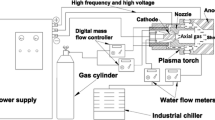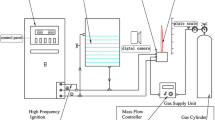Abstract
The non-transferred direct current (DC) plasma torch has been widely used in various industrial applications due to its special jet characteristics. The jet characteristics are determined by different factors, including the working parameters, the torch construction, the gas injection angle (GIA) etc. As there is little study on the influence of the GIA on the jet characteristics, experimental study on the GIA’s effects on the jet characteristics has been carried out on a specially designed non-transferred DC plasma torch, whose GIA can be changed by replacing a gas injection component. The arc voltages and thermal efficiencies of the plasma torch, the specific enthalpies and jet lengths of the plasma jets at different working conditions were obtained and analyzed. It has been found that the GIA greatly affects the arc voltage, the thermal efficiency, the specific enthalpy and the jet length. Based on these findings, plasma torch with appropriate GIA could be used to help generating the plasma jet with desired characteristics.








Similar content being viewed by others
References
Mostaghimi J, Boulos MI (2015) Thermal plasma sources: how well are they adopted to process needs? Plasma Chem Plasma Process 35:421–436
Fauchais P, Vardelle M, Goutier S, Vardelle A (2015) Key challenges and opportunities in suspension and solution plasma spraying. Plasma Chem Plasma Process 35:511–525
Fauchais P (2004) Topical review understanding plasma spraying. J Phys D-Appl Phys 37:86–108
Tendero C, Tixier C, Tristant P, Desmaison J, Leprince P (2006) Atmospheric pressure plasmas: a review. Spectrochim Acta Part B 61:2–29
Misra S, Yu L, Chen W, Foldyna M, Cabarrocas PR (2014) A review on plasma-assisted VLS synthesis of silicon nanowires and radial junction solar cells. J Phys D-Appl Phys 47:3001–3021
Solonenko OP, Smirnov AV (2014) Advanced oxide powders processing based on cascade plasma. J Phys Conf Ser 550:1–10
Suresh K, Selvarajan V, Vijay M (2008) Synthesis of nanophase alumina, and spheroidization of alumina particles, and phase transition studies through DC thermal plasma processing. Vacuum 82:814–820
Shigeta M, Murphy AB (2011) Thermal plasmas for nanofabrication. J Phys D Appl Phys 44:4025–4040
Heberlein J, Murphy AB (2008) Thermal plasma waste treatment. J Phys D-Appl Phys 41:3001–3020
Fabry F, Rehmet C, Rohani V, Fulcheri L (2013) Waste gasification by thermal plasma: a review. Waste Biomass Valor 4:421–439
Solonenko OP, Gulyaev IP, Smirnov AV (2011) Thermal plasma processes for production of hollow spherical powders: theory and experiment. J Therm Sci Technol 6:219–234
Cao X, Yu D, Xiao M, Miao J, Xiang Y, Yao J (2016) Design and characteristics of a laminar plasma torch for materials processing. Plasma Chem Plasma Process 36:693–710
Lermen RT, Machado IG (2012) Development of a new hybrid plasma torch for materials processing. J Mater Process Technol 212:2371–2379
Bobzin K, Bagcivan N, Petkovic I (2011) Numerical and experimental determination of plasma temperature during air plasma spraying with a multiple cathodes torch. J Mater Process Technol 211:1620–1628
Pan W, Meng X, Chen X, Wu C (2006) Experimental study on the thermal argon plasma generation and jet length change characteristics at atmospheric pressure. Plasma Chem Plasma Process 26:335–345
Trelles JP, Chazelas C, Vardelle A, Heberlein JVR (2009) Arc plasma torch modeling. J Therm Spray Technol 18:728–752
Miao J, Yu D, Cao X, Xiang Y, Xiao M, Yao J (2015) Experimental study on the characteristics of a miniature laminar plasma torch with different gas flow patterns. Plasma Chem Plasma Process 35:879–893
Osaki K, Fukumasa O, Kobayashi A (2000) High thermal efficiency-type laminar plasma jet generator for plasma processing. Vacuum 59:47–54
Zhou Q, Yin H, Li H, Xu X, Liu F, Guo S, Chang X, Guo W, Xu P (2009) The EFFECT OF PLASMA-GAS SWIRL flOW ON A HIGHLY CONSTRICTED PLASMA CUTTING ARc. J Phys D-Appl Phys 42:5208–5216
Acknowledgments
The authors appreciate the supports of the National Natural Science Foundation of China (No. 51405315).
Author information
Authors and Affiliations
Corresponding author
Rights and permissions
About this article
Cite this article
Cao, X., Yu, D., Xiang, Y. et al. Influence of the Gas Injection Angle on the Jet Characteristics of a Non-transferred DC Plasma Torch. Plasma Chem Plasma Process 36, 881–889 (2016). https://doi.org/10.1007/s11090-016-9702-9
Received:
Accepted:
Published:
Issue Date:
DOI: https://doi.org/10.1007/s11090-016-9702-9




